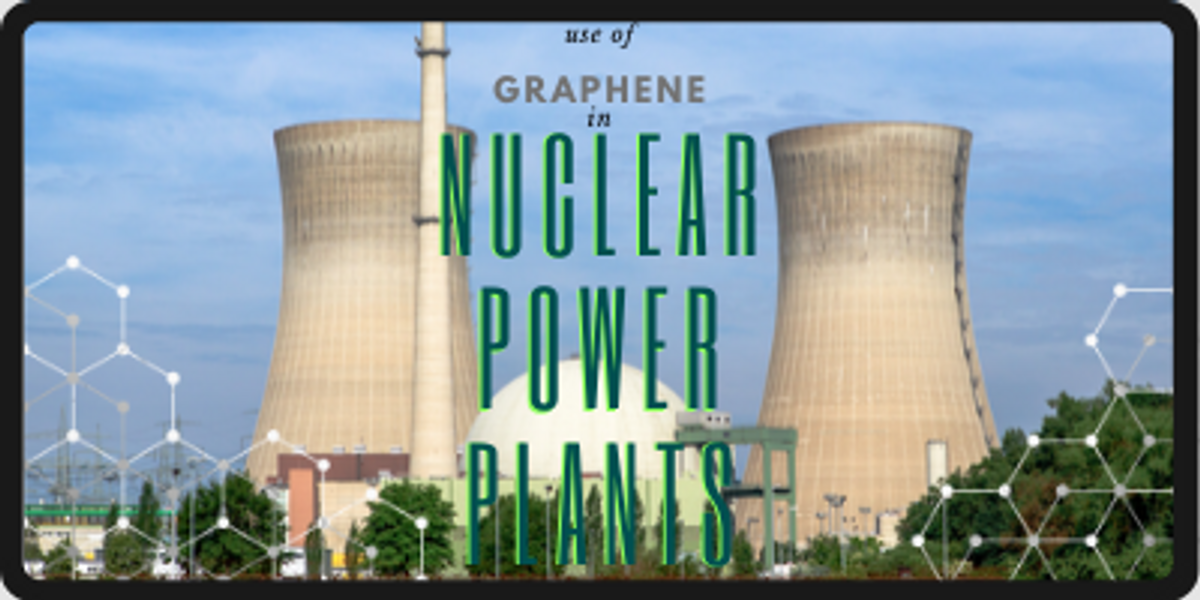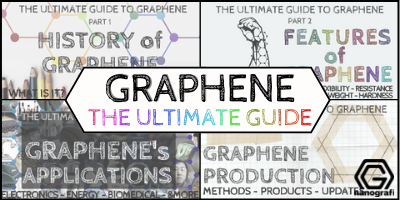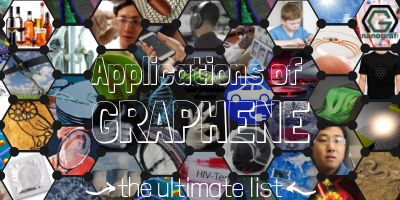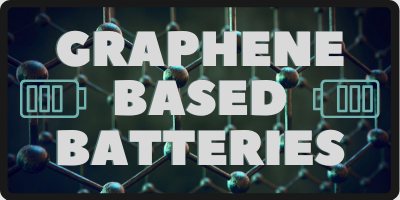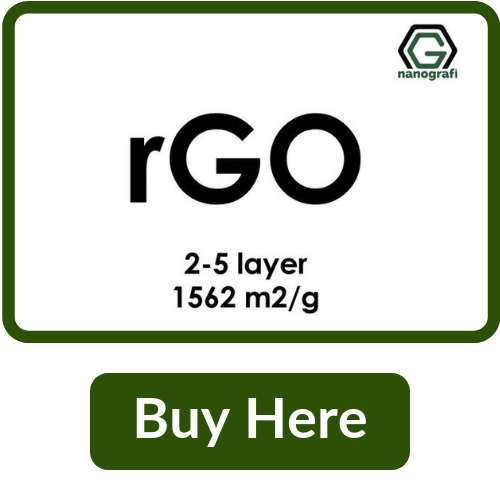Use of Graphene in Nuclear Power Plants
The element Graphene probably means nothing to you. However, it is part of the composition of one of the most common objects that is near you: a pencil. Graphene is a two-dimensional sheet of carbon atoms organized in a honeycomb structure and its stack forms the graphite of our pencil mines.
Graphene was discovered in 2004 by two physicists, Andre Geim and Konstantin Novoselov when it was believed to be physically impossible. Graphene has incredible properties, to the point that it could revolutionize the technology of tomorrow. Each kilo of graphene has the capability to clean 25 grams of radioactivity. In this article, we will specifically discuss the use of Graphene in the Nuclear Power Plant.
Graphene has a very important use in Nuclear Power Plants. Graphene oxide particles dissolve in water very easily and act like a sponge, absorbing radioactive substances and forming lumps. The researchers point out that based on this property of graphene, absolutely new technology can be developed to clean liquids for industrial use, such as those from nuclear plants. Researchers demonstrate the efficiency of graphene to replace metals used in catalysts. Each kilogram of graphene can clean about 25 grams of a radioactive isotope, according to initial calculations by experts in the field.
Properties of Graphene
Considered the thinnest and most resistant material in the world, graphene is obtained from natural graphite, the same used in the manufacture of pencils. It consists of a two-dimensional layer of carbon atoms organized in hexagonal structures, being one of the crystalline forms of carbon, just like a diamond. Its unique characteristics make this element revolutionary. The main characteristics include high conductivity, rigidity superior to that of the diamond, large surface area, lightness, and elasticity. Another hallmark of graphene is its atomic impermeability: not even gas atoms (like helium) can cross a graphene barrier. All of these attributes and properties of graphene favor a multitude of applications, with special attention to the environment and health.
Click Image to Find out more about Graphene in this comprehensive post
Graphene to clean radioactive waste
The discovery of the application of graphene oxide to clean up radioactivity came through researchers from the Department of Chemistry at Moscow State University and Rice University in the United States. Graphene was able to rapidly absorb radioactive substances in aqueous solutions. Microscopic graphene oxide particles dissolve in water very easily. They act like a sponge, absorbing radioactive substances and forming lumps. These lumps can then be removed from the liquid and recycled or burned.
The researchers point out that based on this property of graphene, absolutely new technology can be developed to clean liquids for industrial use, such as those from nuclear plants. The advantages of the method are its simplicity and a high degree of effectiveness. The dean of the Department of Chemistry at Moscow State University, Valeri Lunin, estimates that this is a very promising technology. Neutralizing radioactive waste is one of the main problems facing the economy and science in the 21st century. Graphene oxide can also be used to improve conventional and shale hydrocarbon and rare earth metal extraction technologies.
The process of extracting some raw materials, including rare earth metals, involves bringing to the surface a large amount of water containing natural radionuclides: uranium and radioisotopes. This is a very serious problem. With graphene oxide, this water can be cleaned. This improves the environment in the area of the deposit. This material is effective not only against radionuclides and liquid radioactive waste components but also against heavy metals. In other words, it would work for any water purification system.
Graphene can reduce radioactive waste volume by 90%
Graphene has unique characteristics such as high conductivity, greater rigidity than diamond, large surface area, lightness, and elasticity. Despite campaigns and pressures against nuclear energy, there are 450 nuclear reactors in operation in 33 countries and another 50 plants under construction. The growing need for “clean” alternatives for energy generation is expected to triple the number of nuclear power plants by 2050, making this source now represent 25% of the electricity produced on the planet. This use of graphene was made public during the World Nuclear Energy Congress (AtomExpo) in 2016, on a date that coincided with the 30th anniversary of the Chernobyl accident in Ukraine, the biggest nuclear disaster in history.
A major, if not the biggest problem with nuclear power plants, is the by-product they generate: nuclear waste. This nuclear waste, commonly called nuclear waste, is not exclusive to nuclear power plants. This is also produced in hospitals, research centers, and even in commercial and residential buildings (smoke detectors, lightning rods). As a result, there is a worldwide effort to seek better and safer alternatives for its storage. A group of researchers from the National Nuclear Energy Commission (CNEN), by the radiopharmaceutical Ralph Santos-Oliveira, discovered an unprecedented fact that could revolutionize the storage of nuclear waste. They used graphene, whose single gram can have between 200 and 400 square meters of area, and managed to reduce the volume of radioactive waste by 90%. That is, a gallon of 900 liters is reduced to 90 liters only, which greatly reduces the space for storage. In addition, the use of graphene makes it possible to transform the liquid radioactive waste into solid, further assisting in storage and avoiding the risk of leakage.
With the use of graphene, a gallon of 900 liters is reduced to 90 liters, which greatly reduces the space for storage. In Brazil, there are deposits of provisional nuclear waste in nuclear research centers in Rio de Janeiro, São Paulo, and Minas Gerais. The only permanent deposit is in Goias. According to CNEN, the government agency that oversees the sector, each type of nuclear waste must have a destination and depends on the degree of radioactivity and the materials of which it is composed. The remains of the fuel that moves the nuclear plants are highly radioactive, and the spent uranium tablets are piled up in a cooling pool next to the reactor where they are used. Despite analysts' recommendations to opt for dry storage in containers, many countries continue to deposit atomic waste in swimming pools.
There is a growing lack of interest in the nuclear area in some countries, both in education and training. Therefore, it is needed to offer quality training and qualification. After the leak at the Fukushima plant in Japan in 2011, the second biggest accident in history, countries like Germany, Switzerland and even Japan decided to gradually abandon the use of nuclear energy. Some researchers believe that more than the various campaigns against nuclear energy, it was poorly presented to society. They believe that over time only the negative part of nuclear energy has been presented to society.
Other revolutionary applications of Graphene
Graphene is widely used to make flexible and ultra-resistant electronics.
Graphene alone brings together an impressive number of qualities. Flexible and transparent, it turns out to be a better conductor than silicon, used in particular to make microprocessors for computers. It is also the thinnest, lightest and most resistant material in the world. Thanks to its absence of defects, it has a breaking strength far superior to that of steel while it is not heavier than plastic.
The applications of graphene are innumerable, whether in civil engineering (bridges and viaducts), satellites, planes or everyday objects. By using this crystalline material in place of silicon, computers will become even faster, more efficient and smaller. Graphene also opens the way to flexible and ultra-resistant electronics. Soon, it will be possible to make flexible smartphones that you can fold or wrap around your wrist as well as unbreakable touch screens that could support the weight of an elephant!
Click Image to Learn More About Applications of Graphene
Revolutionary batteries
Ultimately, thanks to its high conductivity, graphene could also revolutionize energy storage technologies and dethrone lithium-ion batteries. These have imposed themselves in recent years but their performance is still limited, particularly in the transport sector. Graphene batteries could recharge much faster, weigh less and have a much longer range.
A Chinese manufacturer recently designed a graphene cell phone battery that charges ten to twenty times faster than lithium-ion batteries. In Spain, a company launched industrial production of graphene batteries last year which, if it is correct, could represent a real leap forward in the energy sector. Thanks to these revolutionary batteries, the range of bikes, motorcycles and electric cars would increase from 65 to 250 kilometers, from 100 to 320 kilometers and from 500 to 800 kilometers, respectively. They would also store 3.7 times more electricity from residential solar panels than Tesla's famous Powerwall.
And this is just the start! In addition to its many intrinsic qualities, graphene also has the advantage of combining with many other materials. The European Commission also set up a Graphene Project in 2015. Endowed with a billion euros over ten years, this project brings together 142 industrial, academic and research groups in 23 countries of the Union. This future nanotechnology star has not finished surprising us and the field of possibilities is far from over.
Click Image to Find Out More About Graphene Based Batteries
How is Graphene Obtained?
Graphene can be obtained in several ways. Some of them are stated below:
- By chemical means, the principle consists of oxidizing graphite in an acid medium (sulfuric acid) then using a reducing solvent (hydrazine) to purify the graphene. This method is neither ecological nor economical and the material obtained is of poor quality.
- By epitaxy, it is the heating of a silicon carbide crystal, in order to release the silicon atoms. Remaining only those of carbon, they will recombine into graphene. But this technique is limited to the support of SiC.
- Ultrasonic exfoliation, with the use of a dispersant. Currently, this method is the subject of numerous subjects of study in order to evaluate its effectiveness.
- Exfoliation with adhesive tape, consisting of removing layer after layer directly on a piece of graphite until only a layer of graphene remains on the substrate. This method is particularly long and laborious.
- By catalytic decomposition at a high temperature of a carbonaceous gas on a metal such as copper, nickel or iridium. However, graphene may oxidize and have a large number of impurities.
In conclusion, Graphene is a revolutionary material having a variety of incredible applications. This is possible due to its exceptional characteristics. Like other sectors, graphene is also used in Nuclear Power Plant. An important application in this regard has been found to reduce radioactive waste from 90% to 9%.
References
https://www.techinasia.com/china-graphene-battery-...
https://www.futurity.org/graphene-flakes-soak-up-r...
https://news.rice.edu/2013/01/08/another-tiny-mira...
https://www.researchgate.net/publication/303896294...
Recent Posts
-
Advanced Materials for Unmanned Aerial Vehicle (UAV) Protection Against Laser
Consider a UAV on a critical mission, rendered inoperative by a sudden laser attack. With the increa …26th Jul 2024 -
Simulation and Modeling of Material Properties
Our world is composed of a dazzling array of materials, each with its own unique properties that dic …19th Jul 2024 -
Advanced Coatings for Superior Corrosion and Wear Resistance
Corrosion and wear pose significant challenges across various industries, leading to substantial eco …12th Jul 2024

